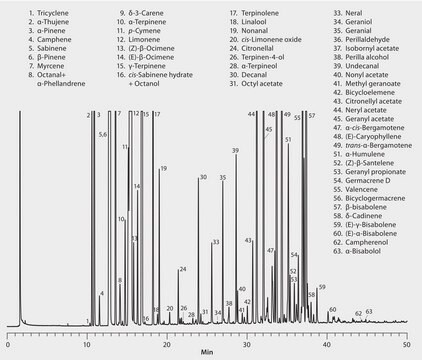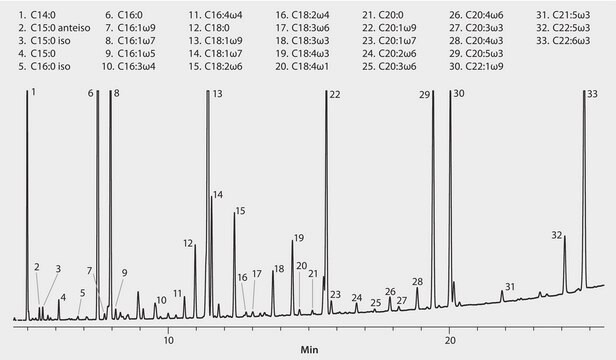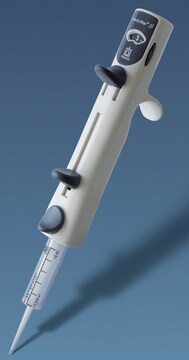28467-U
SLB®-5ms GC-Kapillarsäule
L × I.D. 30 m × 0.25 mm, df 0.10 μm
Synonym(e):
GC-Säule, SPB-5, 5 % Diphenyl, Massenspektrometrie
About This Item
Empfohlene Produkte
Materialien
fused silica
Agentur
Standard Method 6040D
EN 2005/108/EC
EPA 610,625,8015,8082,8100,8141,8270,OLM04.2 SVOA
EPA TO-13,IP-8,8270,525.2,608.1/608.2,608/8081/OLM04.2 PEST
JMHLW
NIOSH 2530,5503
OSHA 62
meets requirements for USP G27 and G36
suitable for EPA 1613
Einhaltung gesetzlicher Vorschriften
FDA LIB 4423
Parameter
-60-340 °C temperature (isothermal)
-60-360 °C temperature (programmed)
Beta-Wert
625
df
0.10 μm
Methode(n)
GC/MS: suitable
gas chromatography (GC): suitable
L × ID
30 m × 0.25 mm
Aktive Matrixgruppe
Bonded and highly crosslinked; silphenylene polymer virtually equivalent in polarity to poly(5% diphenyl/95% dimethyl siloxane) phase
Anwendung(en)
agriculture
chemicals and industrial polymers
cleaning products
clinical
cosmetics
environmental
flavors and fragrances
food and beverages
forensics and toxicology
industrial hygiene
life science and biopharma
personal care
petroleum
pharmaceutical (small molecule)
Säulenart
capillary non-polar
Suchen Sie nach ähnlichen Produkten? Aufrufen Leitfaden zum Produktvergleich
Allgemeine Beschreibung
USP-Code: Diese Säule erfüllt die Anforderungen von USP G27 und G36.
Phase:
- Gebunden und hoch vernetzt
- Das Silphenylen-Polymer ist hinsichtlich seiner Polarität nahezu äquivalent zu Poly(5%-Diphenyl/95%-Dimethylsiloxan)
- ≤0,32 mm ID: -60 °C bis 340 °C (isotherm) oder 360 °C (programmiert)
- ≥0,53 mm ID: -60 °C bis 330 °C (isotherm) oder 340 °C (programmiert)
Anwendung
- An improved method for cyanide determination in blood using solid-phase microextraction and gas chromatography/mass spectrometry.: Diese Studie stellt eine erweiterte Methode zur Bestimmung der Zyanidkonzentration im Blut dar, bei der Festphasen-Mikroextraktion in Kombination mit Gaschromatographie/Massenspektrometrie eingesetzt wird. Diese Technik verbessert die Empfindlichkeit und Genauigkeit, die für die toxikologische und forensische Analyse unerlässlich sind (Frison et al., 2006).
- Photochemical production of conjugated linoleic acid from soybean oil.: In dieser Studie wird die photochemische Produktion konjugierter Linolsäure (CLA) aus Sojaöl untersucht. Die Studie verwendete Gaschromatographie für die Analyse der CLA und demonstrierte eine effiziente Methode zur Herstellung dieser wertvollen Verbindung mit potenziellen gesundheitlichen Vorteilen (Gangidi & Proctor, 2004).
- Development of a solid-phase microextraction GC-NPD procedure for the determination of free volatile amines in wastewater and sewage-polluted waters.: Diese Arbeit beschreibt die Entwicklung eines GC-NPD-Verfahrens mit Festphasenmikroextraktion zum Nachweis flüchtiger Amine in Abwasser. Diese Methode bietet verbesserte Nachweisgrenzen und Spezifität, die für die Umweltüberwachung und die Bewertung der Wasserqualität entscheidend sind (Abalos et al., 1999).
Sonstige Hinweise
Rechtliche Hinweise
Lösungsmittel
Hier finden Sie alle aktuellen Versionen:
Besitzen Sie dieses Produkt bereits?
In der Dokumentenbibliothek finden Sie die Dokumentation zu den Produkten, die Sie kürzlich erworben haben.
Artikel
Sigma-Aldrich presents an article about the analysis of melamine and related compounds in dog food with the use of more economical gas chromatography-mass spectrometry (GC-MS) instrumentation.
Unser Team von Wissenschaftlern verfügt über Erfahrung in allen Forschungsbereichen einschließlich Life Science, Materialwissenschaften, chemischer Synthese, Chromatographie, Analytik und vielen mehr..
Setzen Sie sich mit dem technischen Dienst in Verbindung.




